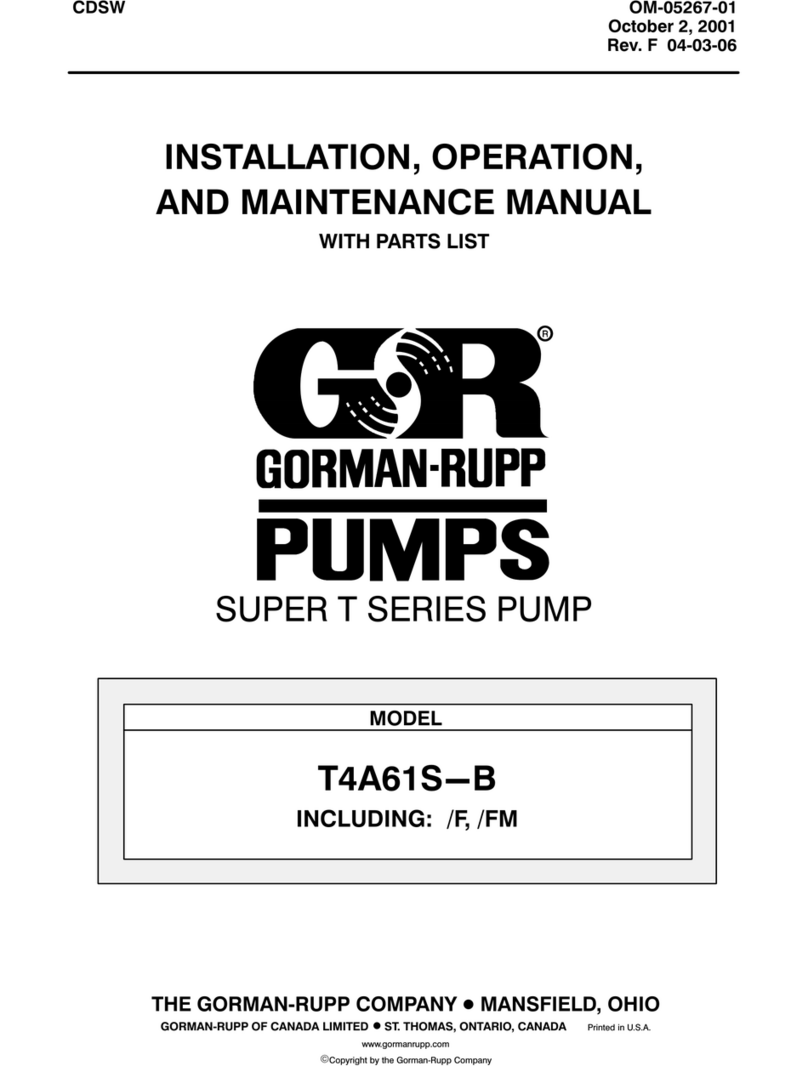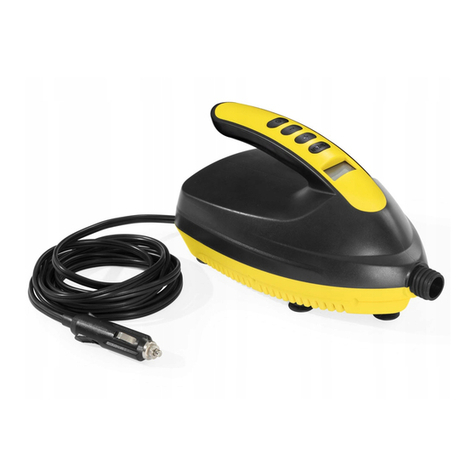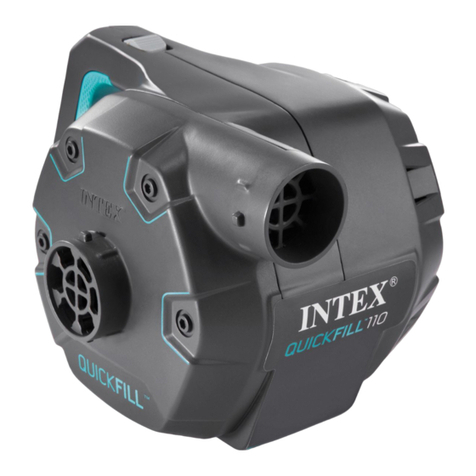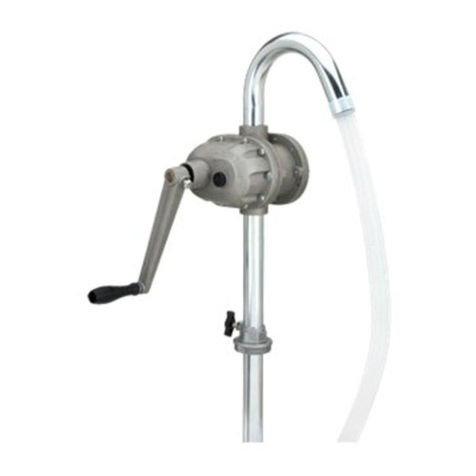GR 0 Series User manual

L OM-02806-OE01
October 10, 1985
Rev. B 06-22-11
THE GORMAN-RUPP COMPANY DMANSFIELD, OHIO
GORMAN-RUPP OF CANADA LIMITED DST. THOMAS, ONTARIO, CANADA Printed in U.S.A.
www.grpumps.com
e1985 The Gorman-Rupp Company
INSTALLATION, OPERATION,
AND MAINTENANCE MANUAL
WITH PARTS LIST
0 SERIES PUMP
MODEL
04A13−(F3L) W/MANF

Register your new
Gorman-Rupp pump online at
www.grpumps.com
Valid serial number and e-mail address required.
RECORD YOUR PUMP MODEL AND SERIAL NUMBER
Please record your pump model and serial number in the
spaces provided below. Your Gorman-Rupp distributor
needs this information when you require parts or service.
Pump Model:
Serial Number:
The engine exhaust from this
product contains chemicals
known to the State of California to
cause cancer, birth defects or
other reproductive harm.

TABLE OF CONTENTS
i
INTRODUCTION PAGE I − 1. . . . . . . . . . . . . . . . . . . . . . . . . . . . . . . . . . . . . . . . . . . . . . . . .
SAFETY − SECTION A PAGE A − 1. . . . . . . . . . . . . . . . . . . . . . . . . . . . . . . . . . . . . . . . . . .
INSTALLATION − SECTION B PAGE B − 1. . . . . . . . . . . . . . . . . . . . . . . . . . . . . . . . . . . .
Pump Dimensions PAGE B − 1. . . . . . . . . . . . . . . . . . . . . . . . . . . . . . . . . . . . . . . . . . . . . . . . . . . . .
PREINSTALLATION INSPECTION PAGE B − 1. . . . . . . . . . . . . . . . . . . . . . . . . . . . . . . . . . . . . . . . . . . .
SECURING PUMP END TO ENGINE PAGE B − 2. . . . . . . . . . . . . . . . . . . . . . . . . . . . . . . . . . . . . . . . .
POSITIONING PUMP PAGE B − 2. . . . . . . . . . . . . . . . . . . . . . . . . . . . . . . . . . . . . . . . . . . . . . . . . . . . . . .
Lifting PAGE B − 2. . . . . . . . . . . . . . . . . . . . . . . . . . . . . . . . . . . . . . . . . . . . . . . . . . . . . . . . . . . . . . . . .
Mounting PAGE B − 2. . . . . . . . . . . . . . . . . . . . . . . . . . . . . . . . . . . . . . . . . . . . . . . . . . . . . . . . . . . . .
SUCTION AND DISCHARGE PIPING PAGE B − 2. . . . . . . . . . . . . . . . . . . . . . . . . . . . . . . . . . . . . . . . .
Materials PAGE B − 3. . . . . . . . . . . . . . . . . . . . . . . . . . . . . . . . . . . . . . . . . . . . . . . . . . . . . . . . . . . . . .
Line Configuration PAGE B − 3. . . . . . . . . . . . . . . . . . . . . . . . . . . . . . . . . . . . . . . . . . . . . . . . . . . . . .
Connections to Pump PAGE B − 3. . . . . . . . . . . . . . . . . . . . . . . . . . . . . . . . . . . . . . . . . . . . . . . . . .
Gauges PAGE B − 3. . . . . . . . . . . . . . . . . . . . . . . . . . . . . . . . . . . . . . . . . . . . . . . . . . . . . . . . . . . . . . .
SUCTION LINES PAGE B − 3. . . . . . . . . . . . . . . . . . . . . . . . . . . . . . . . . . . . . . . . . . . . . . . . . . . . . . . . . . .
Fittings PAGE B − 3. . . . . . . . . . . . . . . . . . . . . . . . . . . . . . . . . . . . . . . . . . . . . . . . . . . . . . . . . . . . . . .
Strainers PAGE B − 3. . . . . . . . . . . . . . . . . . . . . . . . . . . . . . . . . . . . . . . . . . . . . . . . . . . . . . . . . . . . . .
Sealing PAGE B − 3. . . . . . . . . . . . . . . . . . . . . . . . . . . . . . . . . . . . . . . . . . . . . . . . . . . . . . . . . . . . . . .
Suction Line Positioning PAGE B − 3. . . . . . . . . . . . . . . . . . . . . . . . . . . . . . . . . . . . . . . . . . . . . . . .
DISCHARGE LINES PAGE B − 4. . . . . . . . . . . . . . . . . . . . . . . . . . . . . . . . . . . . . . . . . . . . . . . . . . . . . . . .
Siphoning PAGE B − 4. . . . . . . . . . . . . . . . . . . . . . . . . . . . . . . . . . . . . . . . . . . . . . . . . . . . . . . . . . . . .
Valves PAGE B − 4. . . . . . . . . . . . . . . . . . . . . . . . . . . . . . . . . . . . . . . . . . . . . . . . . . . . . . . . . . . . . . . .
OPERATION − SECTION C PAGE C − 1. . . . . . . . . . . . . . . . . . . . . . . . . . . . . . . . . . . . . .
GROUNDING PAGE C − 1. . . . . . . . . . . . . . . . . . . . . . . . . . . . . . . . . . . . . . . . . . . . . . . . . . . . . . . . . . . . .
PRIMING PAGE C − 1. . . . . . . . . . . . . . . . . . . . . . . . . . . . . . . . . . . . . . . . . . . . . . . . . . . . . . . . . . . . . . . . .
Emergency Priming PAGE C − 2. . . . . . . . . . . . . . . . . . . . . . . . . . . . . . . . . . . . . . . . . . . . . . . . . . . .
STARTING PAGE C − 2. . . . . . . . . . . . . . . . . . . . . . . . . . . . . . . . . . . . . . . . . . . . . . . . . . . . . . . . . . . . . . . .
Flooded Suction Application PAGE C − 2. . . . . . . . . . . . . . . . . . . . . . . . . . . . . . . . . . . . . . . . . . . . .
OPERATION PAGE C − 2. . . . . . . . . . . . . . . . . . . . . . . . . . . . . . . . . . . . . . . . . . . . . . . . . . . . . . . . . . . . . .
Leakage PAGE C − 2. . . . . . . . . . . . . . . . . . . . . . . . . . . . . . . . . . . . . . . . . . . . . . . . . . . . . . . . . . . . . .
Strainer Check PAGE C − 2. . . . . . . . . . . . . . . . . . . . . . . . . . . . . . . . . . . . . . . . . . . . . . . . . . . . . . . . .
Liquid Temperature And Overheating PAGE C − 3. . . . . . . . . . . . . . . . . . . . . . . . . . . . . . . . . . . . .
Pump Vacuum Check PAGE C − 3. . . . . . . . . . . . . . . . . . . . . . . . . . . . . . . . . . . . . . . . . . . . . . . . . .
STOPPING PAGE C − 3. . . . . . . . . . . . . . . . . . . . . . . . . . . . . . . . . . . . . . . . . . . . . . . . . . . . . . . . . . . . . . . .
Cold Weather Preservation PAGE C − 3. . . . . . . . . . . . . . . . . . . . . . . . . . . . . . . . . . . . . . . . . . . . . .
BEARING TEMPERATURE CHECK PAGE C − 4. . . . . . . . . . . . . . . . . . . . . . . . . . . . . . . . . . . . . . . . . .
TROUBLESHOOTING − SECTION D PAGE D − 1. . . . . . . . . . . . . . . . . . . . . . . . . . . . . .
PREVENTIVE MAINTENANCE PAGE D − 3. . . . . . . . . . . . . . . . . . . . . . . . . . . . . . . . . . . . . . . . . . . . . . .
PUMP MAINTENANCE AND REPAIR − SECTION E PAGE E − 1. . . . . . . . . . . . . . . .
PERFORMANCE CURVE PAGE E − 1. . . . . . . . . . . . . . . . . . . . . . . . . . . . . . . . . . . . . . . . . . . . . . . . . . .
PARTS LIST:
Pump Model PAGE E − 3. . . . . . . . . . . . . . . . . . . . . . . . . . . . . . . . . . . . . . . . . . . . . . . . . . . . . . . . . .

TABLE OF CONTENTS
(continued)
ii
PUMP AND SEAL DISASSEMBLY PAGE E − 4. . . . . . . . . . . . . . . . . . . . . . . . . . . . . . . . . . . . . . . . . . . .
Pump Casing and Wear Ring Removal PAGE E − 4. . . . . . . . . . . . . . . . . . . . . . . . . . . . . . . . . . . .
Separating Pump From Engine PAGE E − 5. . . . . . . . . . . . . . . . . . . . . . . . . . . . . . . . . . . . . . . . . .
Impeller Removal PAGE E − 5. . . . . . . . . . . . . . . . . . . . . . . . . . . . . . . . . . . . . . . . . . . . . . . . . . . . . .
Seal Removal And Disassembly PAGE E − 5. . . . . . . . . . . . . . . . . . . . . . . . . . . . . . . . . . . . . . . . .
Shaft and Bearing Removal and Disassembly PAGE E − 6. . . . . . . . . . . . . . . . . . . . . . . . . . . . .
Shaft and Bearing Reassembly and Installation PAGE E − 6. . . . . . . . . . . . . . . . . . . . . . . . . . . .
Seal Reassembly and Installation PAGE E − 8. . . . . . . . . . . . . . . . . . . . . . . . . . . . . . . . . . . . . . . .
Impeller Installation PAGE E − 9. . . . . . . . . . . . . . . . . . . . . . . . . . . . . . . . . . . . . . . . . . . . . . . . . . . . .
Securing Pump To Engine PAGE E − 10. . . . . . . . . . . . . . . . . . . . . . . . . . . . . . . . . . . . . . . . . . . . . . .
Pump Casing and Wear Ring Installation PAGE E − 11. . . . . . . . . . . . . . . . . . . . . . . . . . . . . . . . . .
Final Pump Assembly PAGE E − 12. . . . . . . . . . . . . . . . . . . . . . . . . . . . . . . . . . . . . . . . . . . . . . . . . .
LUBRICATION PAGE E − 12. . . . . . . . . . . . . . . . . . . . . . . . . . . . . . . . . . . . . . . . . . . . . . . . . . . . . . . . . . . . .
Seal Assembly PAGE E − 12. . . . . . . . . . . . . . . . . . . . . . . . . . . . . . . . . . . . . . . . . . . . . . . . . . . . . . . . .
Bearings PAGE E − 12. . . . . . . . . . . . . . . . . . . . . . . . . . . . . . . . . . . . . . . . . . . . . . . . . . . . . . . . . . . . . .
Engine PAGE E − 12. . . . . . . . . . . . . . . . . . . . . . . . . . . . . . . . . . . . . . . . . . . . . . . . . . . . . . . . . . . . . . . .

0 SERIES OM−02806
PAGE I − 1INTRODUCTION
INTRODUCTION
Thank You for purchasing a Gorman-Rupp pump.
Read this manual carefully to learn how to safely
install and operate your pump. Failure to do so
could result in personal injury or damage to the
pump. This Installation, Operation, and Mainte-
nance manual is designed to help you achieve the
best performance and longest life from your Gor-
man-Rupp pump.
The pump end less engine is a Gorman-Rupp self-
priming centrifugal model 04A13-(F3L) W/MANF,
and is designed in accordance with MIL-P-52144D.
The model consists of an 0 Series pump end (Army
drawing No. 13220E1066) suction manifold (Army
drawing No. 13220E1072), discharge manifold
(Army drawing No. 13220E1074) and a 4-inch,
180_flanged discharge connection (Army drawing
No. 13220E1076).
The pump is powered by a Deutz F3L diesel en-
gine. If there are any questions regarding the en-
gine, contact:
Deutz Corporation
7587 Ponce DeLeon Circle
Atlanta, Georgia 30340
The Type I pump and manifolds are designed to
deliver aircraft or vehicle fuels at a rate of 350 GPM
at a Total Discharge Head of 275 feet. The Type II
pump and manifolds are preserved during
manufacture to handle clean water at the same
performance level as the Type I pump. If the interior
of the Type II pump becomes contaminated with
fuel, do not use it again for pumping water. See
Section E, Page 1 for performance curves for both
Type I and Type II pumps.
When ordering repair parts, specify whether the
pump is a Type I or Type II. Tf only the pump end
requires replacement, specify Model 04A13-(F3L)
and the manifolds will not be provided. To obtain
repair parts for items not listed in this manual, con-
tact the prime contractor that supplied the end item
assembly.
If there are any questions regarding the pump or its
application which are not covered in this manual or
in other literature accompanying this unit, please
contact your Gorman-Rupp distributor, or:
The Gorman-Rupp Company
P.O. Box 1217
Mansfield, Ohio 44901−1217
Phone: (419) 755−1011
or:
Gorman-Rupp of Canada Limited
70 Burwell Road
St. Thomas, Ontario N5P 3R7
Phone: (519) 631−2870
For information or technical assistance on the en-
gine, contact the engine manufacturer’s local
dealer or representative.
The following are used to alert maintenance per-
sonnel to procedures which require special atten-
tion, to those which could damage equipment, and
to those which could be dangerous to personnel:
Immediate hazards which WILL result in se-
vere personal injury or death. These in-
structions describe the procedure required
and the injury which will result from failure
to follow the procedure.
Hazards or unsafe practices which COULD
result in severe personal injury or death.
These instructions describe the procedure
required and the injury which could result
from failure to follow the procedure.
Hazards or unsafe practices which COULD re-
sult in minor personal injury or product or
property damage. These instructions describe
the requirements and the possible damage
which could result from failure to follow the
procedure.
NOTE
Instructions to aid in installation, operation, and
maintenance or which clarify a procedure.

0 SERIES OM−02806
PAGE A − 1SAFETY
SAFETY − SECTION A
This information applies to 0 Series en-
gine driven pumps. Refer to the manual
accompanying the engine before at-
tempting to begin operation.
Because pump installations are seldom
identical, this manual cannot possibly
provide detailed instructions and pre-
cautions for each specific application.
Therefore, it is the owner/installer’s re-
sponsibility to ensure that applications
not addressed in this manual are per-
formed only after establishing that nei-
ther operator safety nor pump integrity
are compromised by the installation.
Before attempting to open or service the
pump:
1. Familiarize yourself with this man-
ual.
2. Shut down the engine and discon-
nect the positive battery cable to
ensure that the pump will remain
inoperative.
3. Allow the pump to completely cool
if overheated.
4. Check the temperature before
opening any covers, plates, or
plugs.
5. Close the suction and discharge
valves.
6. Vent the pump slowly and cau-
tiously at the drain plug.
7. Drain the pump.
This pump is may be used to handle air-
craft and vehicle fuels for Type I pumps,
or clear water for Type II pumps. Do not
attempt to pump corrosive liquids, or
any liquids which may damage the
pump or endanger personnel as a result
of pump failure.
If the pump is used for petroleum prod-
ucts, be certain proper safety practices
are followed before operating or servic-
ing the pump. Provide adequate ventila-
tion, prohibit smoking, wear static-re-
sistant clothing and shoes. Clean up all
fuel spills immediately after occur-
rence.
Do not operate the pump against a
closed discharge valve for long periods
of time. If operated against a closed dis-
charge valve, pump components will
deteriorate, and the liquid could come
to a boil, build pressure, and cause the
pump casing to rupture or explode.
Overheated pumps can cause severe
burns and injury. If overheating of the
pump occurs:
1. Stop the pump immediately.
2. Allow the pump to completely cool.
3. Refer to instructions in this manual
before re-starting the pump.
If pumping fuel, overheating may pro-
duce dangerous fumes. Take precau-
tions to ensure the area surrounding the
pump is adequately ventilated. Allow
the pump to completely cool and use ex-
treme caution when venting the pump or

0 SERIES
OM−02806
PAGE A − 2 SAFETY
when removing covers, plates, plugs, or
fittings.
Do not remove plates, covers, gauges,
pipe plugs, or fittings from an over-
heated pump. Vapor pressure within the
pump can cause parts being disen-
gaged to be ejected with great force. Al-
low the pump to completely cool before
servicing.
After the pump has been installed, make
certain that the pump and all piping con-
nections are tight, properly supported
and secure before operation.
Do not operate an internal combustion
engine in an explosive atmosphere.
When operating internal combustion
engines in an enclosed area, make cer-
tain that exhaust fumes are piped to the
outside. These fumes contain carbon
monoxide, a deadly gas that is color-
less, tasteless, and odorless.
Fuel used by internal combustion en-
gines presents an extreme explosion
and fire hazard. Make certain that all
fuel lines are securely connected and
free of leaks. Never refuel a hot or run-
ning engine. Avoid overfilling the fuel
tank. Always use the correct type of fuel.
Never tamper with the governor to gain
more power. The governor establishes
safe operating limits that should not be
exceeded. The maximum continuous
operating speed for this pump is 2400
RPM.

OM−028060 SERIES
PAGE B − 1INSTALLATION
INSTALLATION − SECTION B
Review all SAFETY information in Section A.
Since pump installations are seldom identical, this
section offers only general recommendations and
practices required to inspect, position, and ar-
range the pump and piping.
Most of the information pertains to a standard
static lift application where the pump is positioned
above the free level of liquid to be pumped.
If installed in a flooded suction application where
the liquid is supplied to the pump under pressure,
some of the information such as mounting, line
configuration, and priming must be tailored to the
specific application. Since the pressure supplied
to the pump is critical to performance and safety,
be sure to limit the incoming pressure to 50% of the
maximum permissible operating pressure as
shown on the pump performance curve(s) (see
Section E, Page 1).
Pump Dimensions
See Figure 1 for the approximate physical dimen-
sions of this pump.
OUTLINE DRAWING
Figure 1. Pump Model 04A13−(4/10) W/MANF
PREINSTALLATION INSPECTION
The pump assembly was inspected and tested be-
fore shipment from the factory. Before installation,
inspect the pump for damage which may have oc-
curred during shipment. Check as follows:
a. Inspect the pump for cracks, dents, damaged
threads, and other obvious damage.
b. Check for and tighten loose attaching hard-
ware. Since gaskets tend to shrink after dry-
ing, check for loose hardware at mating sur-
faces.

OM−02806 0 SERIES
PAGE B − 2 INSTALLATION
c. Check all lubricant levels and lubricate as
necessary. Refer to LUBRICATION in MAIN-
TENANCE AND REPAIR, and perform all du-
ties as instructed.
d. Carefully read all tags, decals, and markings
on the pump assembly, and perform all duties
indicated.
e. If the pump end has been stored for more than
12 months, some of the components or lubri-
cants may have exceeded their maximum
shelf life. These must be inspected or re-
placed to ensure maximum pump service.
If the maximum shelf life has been exceeded, or if
anything appears to be abnormal, contact your
Gorman-Rupp distributor or the factory to deter-
mine the repair or updating policy. Do not put the
pump into service until appropriate action has
been taken.
SECURING PUMP END TO ENGINE
Use lifting and moving equipment in
good repair and with adequate capacity
to prevent injuries to personnel or dam-
age to equipment. If chains or cable are
wrapped around the pump end to lift it,
make certain that they are positioned so
as not to damage the pump end, and so
that the load will be balanced.
Check the shipping tag on the unit packaging for
the pump end weight, and use lifting equipment
with appropriate capacity for mounting the pump
end to the engine.
Refer to Securing Pump End To Engine in Section
E, MAINTENANCE AND REPAIR for pump end
mounting instructions.
POSITIONING PUMP
Use lifting and moving equipment in
good repair and with adequate capacity
to prevent injuries to personnel or dam-
age to equipment. Suction and dis-
charge hoses and piping must be re-
moved from the pump before lifting.
Lifting
Pump unit weights will vary depending on the
mounting and drive provided. Drain the pump and
remove all customer-installed equipment such as
suction and discharge hoses or piping before at-
tempting to lift existing, installed units.
If chains or cables are used to lift the pump, make
certain that they are positioned so that they will not
damage the pump, and so that the load will be bal-
anced.
Mounting
Locate the pump in an accessible place as close as
practical to the liquid being pumped. Level mount-
ing is essential for proper operation. The pump
may have to be supported or shimmed to provide
for level operation or to eliminate vibration.
To ensure sufficient lubrication and fuel supply to
the engine, do not position the pump and engine
more than 15_off horizontal for continuous opera-
tion. The pump and engine may be positioned up
to 30_off horizontal for intermittent operation
only; however, the engine manufacturer should be
consulted for continuous operation at angles
greater than 15_.
If the pump has been mounted on a moveable
base, make certain the base is stationary by setting
the brake and chocking the wheels before attempt-
ing to operate the pump.
SUCTION AND DISCHARGE PIPING
Check the torque on the nuts securing the
suction and discharge manifolds to the
pump casing before putting the pump into
service. If the nuts are plated, torque the
nuts to 15.3 ft. lbs. If the nuts are not plated,
torque them to 17.0 ft. lbs.

OM−028060 SERIES
PAGE B − 3INSTALLATION
Pump performance is adversely effected by in-
creased suction lift, discharge elevation, and fric-
tion losses. See the performance curves in MAIN-
TENANCE AND REPAIR to be sure your overall
application allows pump to operate within the safe
operation range.
Materials
Either pipe or hose maybe used for suction and
discharge lines; however, the materials must be
compatible with the liquid being pumped. If hose is
used in suction lines, it must be the rigid-wall, rein-
forced type to prevent collapse under suction. Us-
ing piping couplings in suction lines is not recom-
mended.
Line Configuration
Keep suction and discharge lines as straight as
possible to minimize friction losses. Make mini-
mum use of elbows and fittings, which substan-
tially increase friction loss. If elbows are necessary,
use the long-radius type to minimize friction loss.
Connections to Pump
Before tightening a connecting flange, align it ex-
actly with the pump port. Never pull a pipe line into
place by tightening the flange bolts and/or cou-
plings.
Lines near the pump must be independently sup-
ported to avoid strain on the pump which could
cause excessive vibration, decreased bearing life,
and increased shaft and seal wear. If hose-type
lines are used, they should have adequate support
to secure them when filled with liquid and under
pressure.
SUCTION LINES
To avoid air pockets which could affect pump prim-
ing, the suction line must be as short and direct as
possible. When operation involves a suction lift, the
line must always slope upward to the pump from
the source of the liquid being pumped; if the line
slopes down to the pump at any point along the
suction run, air pockets will be created.
Fittings
Suction lines should be the same size as the pump
inlet. If reducers are used in suction lines, they
should be the eccentric type, and should be in-
stalled with the flat part of the reducers uppermost
to avoid creating air pockets. Valves are not nor-
mally used in suction lines, but if a valve is used,
install it with the stem horizontal to avoid air pock-
ets.
Strainers
A suction strainer was not furnished with this pump
since it is not desighed to handle liquids containing
solids. However, if a strainer is installed by the user,
make certain that the total area of the openings in
the strainer is at least three or four times the cross
section of the suction line, and that the openings
will not permit passage of solids larger than the sol-
ids handling capability of the pump.
Damage to the pump resulting from debris
in the suction line will not be covered by the
pump warranty.
This pump is designed to handle up to 9/16 inch
(14,3 mm) diameter spherical solids.
Sealing
Since even a slight leak will affect priming, head,
and capacity, especially when operating with a
high suction lift, all connections in the suction line
should be air tight.
Suction Line Positioning
The depth of submergence of the suction line is
critical to efficient pump operation. Figure 2 shows
recommended minimum submergence vs. veloc-
ity.

OM−02806 0 SERIES
PAGE B − 4 INSTALLATION
NOTE
The pipe submergence required may be reduced
by installing a standard pipe increaser fitting at the
end of the suction line. The larger opening size will
reduce the inlet velocity. Calculate the required
submergence using the following formula based
on the increased opening size (area or diameter).
Figure 2. Recommended Minimum Suction Line Submergence vs. Velocity
DISCHARGE LINES
Siphoning
Do not terminate the discharge line at a level lower
than that of the liquid being pumped unless a si-
phon breaker is used in the line. Otherwise, a si-
phoning action causing damage to the pump
could result.
Valves
This pump is fitted with manually-operated suction
and discharge valves. By alternately opening and
closing these valves, more than one type of liuid
(fuel) can be pumped from and to different loca-
tions withoug repositioning the suction and dis-
charge lines each time. See Section C, Flooded
Suction Application, for valve and discharge el-
bow use when pumping above the level of the
pump.
The discharge valves are throttling valves; howev-
er, the suction valves are not throttling valves and
should never be used as such.
With high discharge heads, use the discharge
throttling valves and discharge check valve to pro-
tect the pump from excessive shock pressure and
reverse rotation when it is stopped.
If the application involves a high discharge
head, gradually close the discharge
throttling valves before stopping the
pump.

OM−02806
0 SERIES
OPERATION PAGE C − 1
OPERATION − SECTION C
Review all SAFETY information in Section A.
Follow the instructions on all tags, labels and
decals attached to the pump.
This pump is designed to handle aircraft
and vehicle fuels for Type I pumps, or
clear water for Type II pumps. Do not at-
tempt to pump corrosive liquids, or any
liquids which may damage the pump or
endanger personnel as a result of pump
failure.
GROUNDING
To eliminate electrostatic build-up when pumping
fuel, the pump must be grounded before opera-
tion. Ground the pump by attaching a ground wire
to a ground rod. Install the ground rod in accor-
dance with the National Electrical Codes and all lo-
cal codes. Be sure the clamp or fastener has made
a tight electrical connection with the rod.
Inspect and test the ground wire assembly
for conductivity. Replace broken or frayed
wire before resuming operation.
PRIMING
Install the pump and piping as described in IN-
STALLATION. Make sure that the piping connec-
tions are tight, and that the pump is securely
mounted. Check that the pump is properly lubri-
cated (see LUBRICATION in MAINTENANCE
AND REPAIR).
This pump is self-priming, but should never be op-
erated unless there is liquid in the pump casing.
Never operate this pump unless there is
liquid in the pump casing. The pump will
not prime when dry. Extended operation of
a dry pump will destroy the seal assembly.
Add liquid to the casing when:
1. The pump is being put into service for the first
time.
2. The pump has not been used for a consider-
able length of time.
3. The liquid in the casing has evaporated.
Once the pump casing has been filled, the pump
will prime and reprime as necessary.
After filling the casing, reinstall the fill
cap. Do not attempt to operate the pump
unless all connecting piping is securely
installed. Otherwise, liquid in the pump
forced out under pressure could cause
injury to personnel.
To fill the pump, remove the priming cap at the top
of the casing and add clean liquid until the pump is
filled. Replace the priming cap before operation.
The amount of time required to prime the pump va-
ries with relation to the following:
1. Length of suction hose.
2. Height of pump above source of liquid to be
pumped.
3. Liquid temperature.
4. Type of liquid being pumped.
The lesser the values of items 1, 2 and 3, the short-
er the priming time.
Emergency Priming
The priming operation heats the liquid in the pump
casing. If the liquid heats to the point of vaporiza-

OM−02806 0 SERIES
OPERATIONPAGE C − 2
tion (boiling), priming cannot be accomplished. If
vaporization occurs, shut the pump off and allow
the pump and liquid to cool enough to safely open
the priming cap. Drain the casing and refill with
cool liquid or, if possible, a liquid with a lower vapor
pressure (Mogas has the highest vapor pressure,
jet fuels a lower vapor pressure, and water the low-
est vapor pressure.)
NOTE
When operation requires drawing suction from
both suction inlets, close one of the suction valves
and prime the pump from the open portion of the
system before opening the second suction valve.
STARTING
Consult the operations manual furnished with the
engine. Check the engine lubrication as described
in the literature accompanying the engine and fill
the fuel tank with fuel.
Open the suction and discharge valves. Start the
engine and operate between 2100 and 2400 RPM
(best priming speed.)
Priming is indicated by a positive reading on the
discharge pressure gauge and/or quieter opera-
tion. When priming begins, reduce the engine
speed to idle and close the discharge valve so it is
1/3 to 1/2 open.
Failure to reduce the valve opening and en-
gine speed to idle during priming can
cause severe hydraulic shock if the line is
filled too fast, resulting in hose rupture and
fitting failure.
The pump may not prime immediately because the
suction line must first fill with liquid. When the dis-
charge line is full, increase the engine RPM and ad-
just the discharge valve to achieve the desired flow
rate. If the pump fails to prime within a few minutes,
stop the pump and check the suction line for leaks.
Flooded Suction Application
When installed in a flooded suction application,
simply open the system valves and permit the in-
coming liquid to evacuate the air. After the pump
and piping system have completely filled, evacu-
ate any remaining air pockets in the pump or suc-
tion line by opening the bleeder valve on top of the
180_discharge elbow. When a solid stream of liq-
uid is discharged from the bleeder valve, close the
valve and open the discharge valve(s).
OPERATION
Pump speed and operating condition
points must be within the continuous per-
formance range shown on the curves (see
Section E, Page 1).
Leakage
No leakage should be visible at pump mating sur-
faces, or at pump connections or fittings. Keep all
line connections and fittings tight to maintain maxi-
mum pump efficiency.
Strainer Check
If a suction strainer has been installed by the user,
check the strainer regularly, and clean it as neces-
sary. The strainer should also be checked if pump
flow rate begins to drop. If a vacuum suction gauge
has been installed, monitor and record the read-
ings regularly to detect strainer blockage.
Never introduce air or steam pressure into the
pump casing or piping to remove a blockage. This
could result in personal injury or damage to the
equipment. If backflushing is absolutely neces-
sary, liquid pressure must be limited to 50% of the
maximum permissible operating pressure shown
on the pump performance curve (see Section E,
Page 1).
Liquid Temperature And Overheating
The maximum liquid temperature for this pump is
160_F (71_C). Do not apply it at a higher operating
temperature.

OM−02806
0 SERIES
OPERATION PAGE C − 3
Overheating can occur if operated with the valves
in the suction or discharge lines closed. Operating
against closed valves could bring the liquid to a
boil, build pressure, and cause the pump to rup-
ture or explode. If overheating occurs, stop the
pump and allow it to completely cool before servic-
ing it. Refill the pump casing with cool liquid.
Allow an over-heated pump to com-
pletely cool before servicing. Do not re-
move plates, covers, gauges, pipe
plugs, or fittings from an overheated
pump. Vapor pressure within the pump
can cause parts being disengaged to be
ejected with great force. After the pump
completely cools, drain the liquid from
the pump by removing the casing drain
plug. Use caution when removing the
plug to prevent injury from hot liquid.
Pump Vacuum Check
Since the pump does not have a suction check
valve, the discharge line must be fitted with a check
valve if a pump vacuum reading is taken.
Close both suction valves, start the pump, and ob-
serve the suction vacuum gauge. At operating
speed the pump should pull a vacuum of 15 to 17
inches or more of mercury when pumping petro-
leum. When puming water, it should develop 20
inches or more of mercury. If it does not, check for
air leaks in the seal, gasket, or discharge valve.
Open the suction valves, and read the vacuum
gauge with the pump primed and at operating
speed. Shut off the pump. The vacuum gauge
reading will immediately drop proportional to the
static suction lift, and should then stabilize. If the
vacuum reading falls off rapidly after stabilization,
an air leak exists. Before checking for the source of
the leak, check the point of installation of the vac-
uum gauge.
NOTE
Petroleum products are very sensitive to changes
in temperature. Warmer temperatures elevate the
product vapor pressure, resulting in low vacuum
readings. Do not mistake temperature problems for
faulty pump installation or performance.
STOPPING
Never halt the flow of liquid suddenly. If the liquid
being pumped is stopped abruptly, damaging
shock waves can be transmitted to the pump and
piping system. Close all connecting valves slowly.
Reduce the throttle speed slowly and allow the en-
gine to idle briefly before stopping.
If the application involves a high discharge
head, gradually close the discharge
throttling valve before stopping the pump.
After stopping the pump, shut down the engine
and remove the key or take other precautions to
ensure that the pump will remain inoperative.
Cold Weather Preservation
If the pump will be idle for more than a few hours in
below freezing conditions, drain the pump to pre-
vent damage from freezing, particularly if pumping
water. If necessary, dlean out any small solids by
flushing with a hose. Operate the pump for approx-
imately one minute; this wil remove any remaining
liquid that could freeze the pump rotating parts.
BEARING TEMPERATURE CHECK
Bearings normally run at higher than ambient tem-
peratures because of heat generated by friction.
Temperatures up to 160_F (71_C) are considered
normal for bearings, and they can operate safely to
at least 180_F (82_C).
Checking bearing temperatures by hand is inaccu-
rate. Bearing temperatures can be measured ac-
curately by placing a contact-type thermometer
against the housing. Record this temperature for
future reference.
A sudden increase in bearing temperature is a
warning that the bearings are at the point of failing

OM−02806 0 SERIES
OPERATIONPAGE C − 4
to operate properly. Make certain that the bearing
lubricant is of the proper viscosity and at the cor-
rect level (see LUBRICATION in MAINTENANCE
AND REPAIR). Bearing overheating can also be
caused by shaft misalignment and/or excessive vi-
bration.
When pumps are first started, the bearings may
seem to run at temperatures above normal. Con-
tinued operation should bring the temperatures
down to normal levels.

TROUBLE POSSIBLE CAUSE PROBABLE REMEDY
PUMP FAILS TO
PRIME
PUMP STOPS OR
FAILS TO DELIVER
RATED FLOW OR
PRESSURE
0 SERIES OM−02806
TROUBLESHOOTING PAGE D − 1
TROUBLESHOOTING − SECTION D
Review all SAFETY information in Section A.
Before attempting to open or service the
pump:
1. Familiarize yourself with this manual.
2. Shut down the engine and disconnect
the positive battery cable to ensure
that the pump will remain inoperative.
3. Allow the pump to completely cool if
overheated.
4. Check the temperature before open-
ing any covers, plates, or plugs.
5. Close the suction and discharge
valves.
6. Vent the pump slowly and cautiously.
7. Drain the pump.
Not enough liquid in casing. Add liquid to casing. See PRIMING,
Section B.
Air leak in suction line. Correct leak.
Lining of suction hose collapsed. Replace suction hose.
Leaking or worn seal or pump gasket. Check pump vacuum. Replace leak
-ing or worn seal or gasket.
Suction valve(s) closed or clogged. Open or clean valve(s).
Suction lift or discharge head too high. Check piping installation and
install bypass line if needed. See
INSTALLATION.
Strainer clogged. Check strainer and clean if necessary.
Air leak in suction line. Correct leak.
Suction intake not submerged at Check installation and correct sub-
proper level or sump too small. mergence as needed.
Lining of suction hose collapsed. Replace suction hose.
Impeller or other wearing parts worn or Replace worn or damaged parts.
damaged. Check that impeller is properly
centered and rotates freely.

TROUBLE POSSIBLE CAUSE PROBABLE REMEDY
PUMP REQUIRES
TOO MUCH
POWER
BEARINGS RUN
TOO HOT
PUMP CLOGS
FREQUENTLY
EXCESSIVE
NOISE
OM−02806 0 SERIES
TROUBLESHOOTINGPAGE D − 2
Pump speed too high. Check engine output.
Discharge head too low. Adjust discharge valve.
Liquid solution too thick. Dilute if possible.
Discharge flow too slow. Open discharge valve fully to in-
crease flow rate, and run engine
at maximum governed speed.
Discharge throttling valve partially Open discharge valve fully; check pip-
closed; check valve is installed improp- ing installation.
erly.
Discharge line clogged or restricted; Check discharge lines; straighten
hose kinked. hose.
Cavitation in pump. Reduce suction lift and/or fric-
tion losses in suction line. Record
vacuum and pressure gauge read-
ings and consult local representa-
tive or factory.
Pumping entrained air. Locate and eliminate source of air
bubble.
Pump or drive not securely mounted. Secure mounting hardware.
Impeller clogged or damaged. Clean out debris; replace damaged
parts.
Bearing temperature is high, but within Check bearing temperature regularly
limits. to monitor any increase.
Low or incorrect lubricant. Check for proper type and level of
lubricant.
Suction and discharge lines not Check piping installation for proper
properly supported. support.
Drive misaligned. Align drive properly.

0 SERIES OM−02806
TROUBLESHOOTING PAGE D − 3
PREVENTIVE MAINTENANCE
Since pump applications are seldom identical, and
pump wear is directly affected by such things as
the abrasive qualities, pressure and temperature
of the liquid being pumped, this section is intended
only to provide general recommendations and
practices for preventive maintenance. Regardless
of the application however, following a routine pre-
ventive maintenance schedule will help assure
trouble-free performance and long life from your
Gorman-Rupp pump. For specific questions con-
cerning your application, contact your Gorman-
Rupp distributor or the Gorman-Rupp Company.
Record keeping is an essential component of a
good preventive maintenance program. Changes
in suction and discharge gauge readings (if so
equipped) between regularly scheduled inspec-
tions can indicate problems that can be corrected
before system damage or catastrophic failure oc-
curs. The appearance of wearing parts should also
be documented at each inspection for comparison
as well. Also, if records indicate that a certain part
(such as the seal) fails at approximately the same
duty cycle, the part can be checked and replaced
before failure occurs, reducing unscheduled down
time.
For new applications, a first inspection of wearing
parts at 250 hours will give insight into the wear rate
for your particular application. Subsequent inspec-
tions should be performed at the intervals shown
on the chart below. Critical applications should be
inspected more frequently.
General Condition (Temperature, Unusual
Noises or Vibrations, Cracks, Leaks,
Loose Hardware, Etc.) I
Pump Performance (Gauges, Speed, Flow) I
Bearing Lubrication I R
Seal Lubrication (And Packing Adjustment,
If So Equipped) I R
V-Belts (If So Equipped) I
Air Release Valve Plunger Rod (If So Equipped) I C
Front Impeller Clearance (Wear Plate) I
Rear Impeller Clearance (Seal Plate) I
Check Valve I
Pressure Relief Valve (If So Equipped) C
Pump and Driver Alignment I
Shaft Deflection I
Bearings I
Bearing Housing I
Piping I
Driver Lubrication − See Mfgr’s Literature
Legend:
I = Inspect, Clean, Adjust, Repair or Replace as Necessary
C = Clean
R = Replace
* Service interval based on an intermittent duty cycle equal to approximately 4000 hours annually.
Adjust schedule as required for lower or higher duty cycles or extreme operating conditions.
Preventive Maintenance Schedule
Item Daily Weekly Monthly Semi-
Annually
Annually
Service Interval*

OM−02806
0 SERIES
MAINTENANCE & REPAIR PAGE E − 1
PUMP MAINTENANCE AND REPAIR − SECTION E
MAINTENANCE AND REPAIR OF THE WEARING PARTS OF THE PUMP WILL MAINTAIN PEAK
OPERATING PERFORMANCE.
MODEL 04A13−(F3L) W/MANF PERFORMANCE FOR PUMPING PETROLEUM
MODEL 04A13−(F3L) W/MANF PERFORMANCE FOR PUMPING WATER
Based on 70_F (21_C) clear water (or corrected
to .75 specific gravity) at sea level, with minimum
suction lift. Since pump installations are seldom
identical, your performance may be different due
to such factors as viscosity, specific gravity, eleva-
tion, temperature, and impeller trim.
Pump speed and performance condition
points must be within the operating range
shown on the curve.

0 SERIESOM−02806
MAINTENANCE & REPAIRPAGE E − 2
PARTS PAGE
SECTION DRAWING
Figure 1. Pump Model 04A13−(F3L) W/MANF
This manual suits for next models
2
Table of contents
Other GR Water Pump manuals
Popular Water Pump manuals by other brands
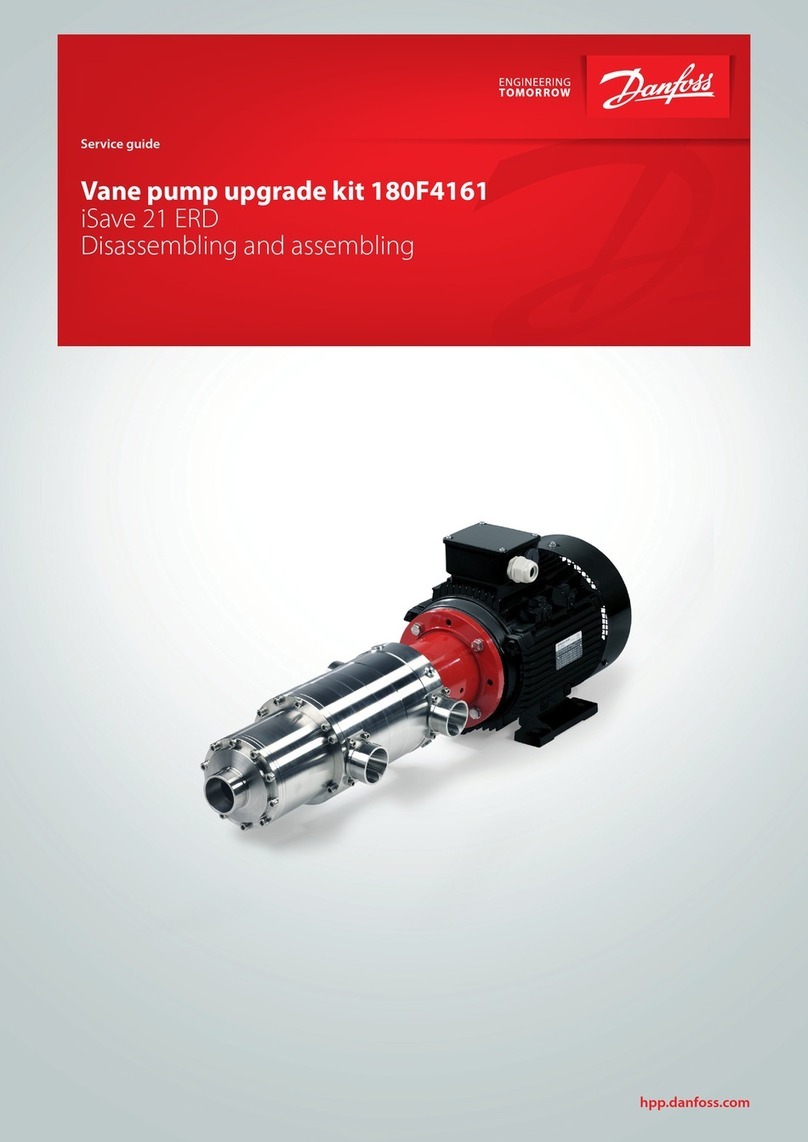
Danfoss
Danfoss 180F4161 Service guide
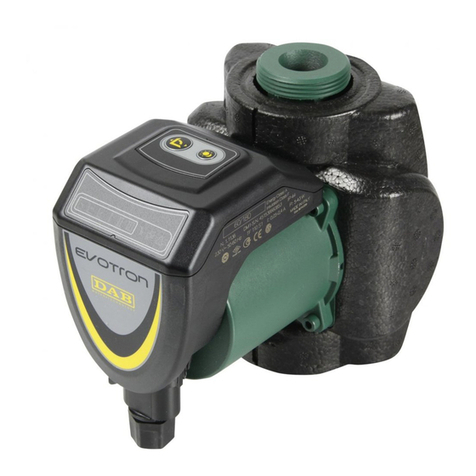
DAB
DAB EVOTRON Instruction
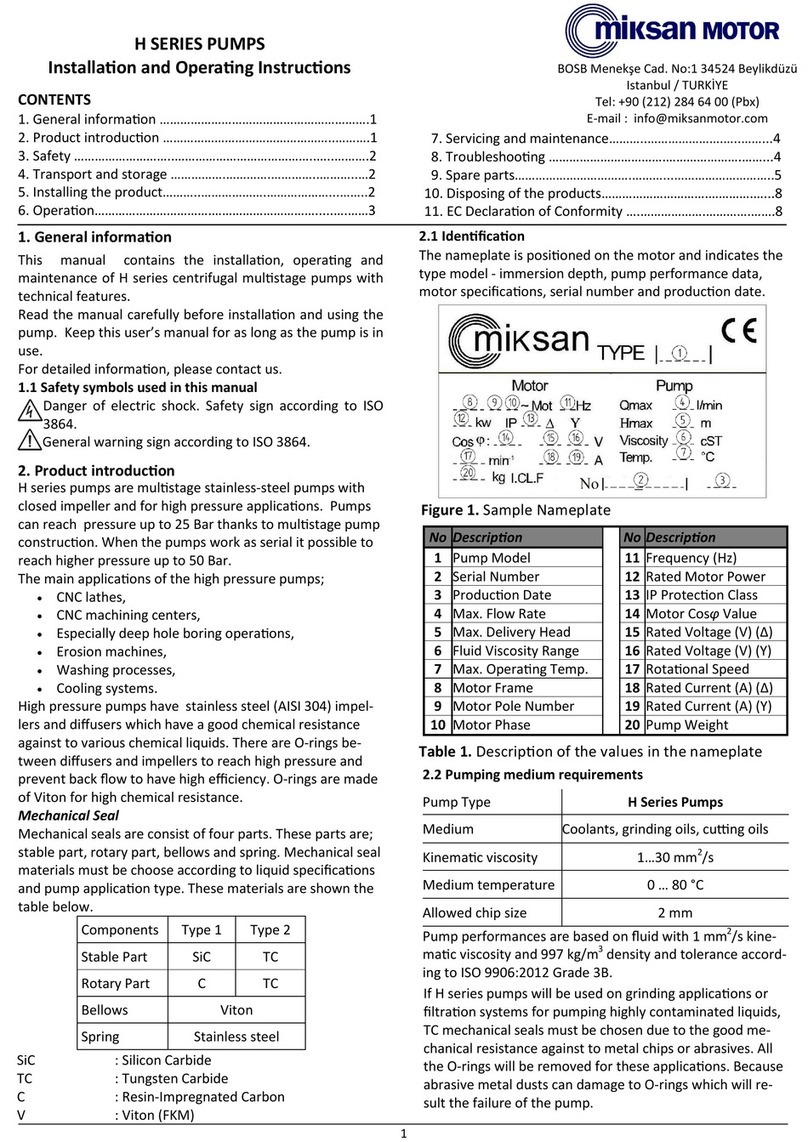
Miksan Motor
Miksan Motor H Series Installation and operating instructions
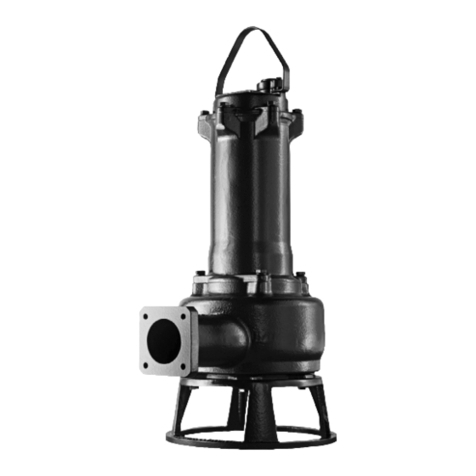
Grundfos
Grundfos DPK Series Installation and operating instructions

TotalPond
TotalPond 52213 quick start guide
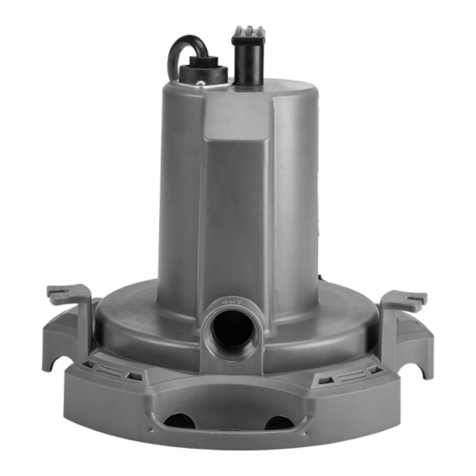
Harbor Freight Tools
Harbor Freight Tools Drummond 57038 owner's manual
